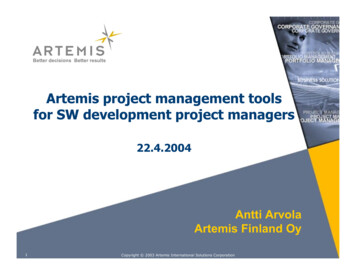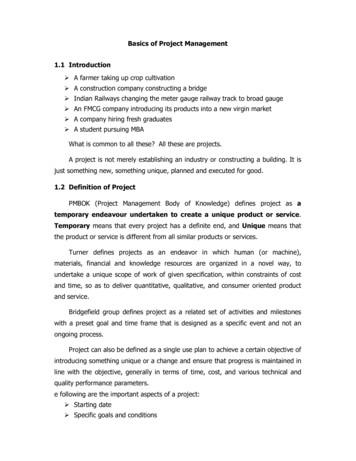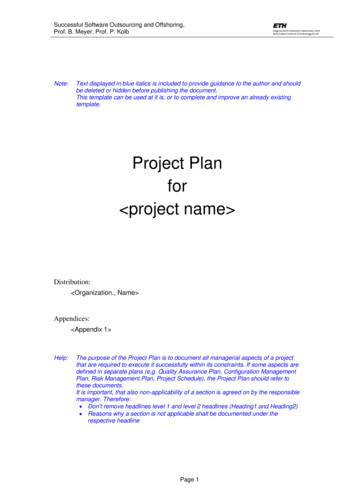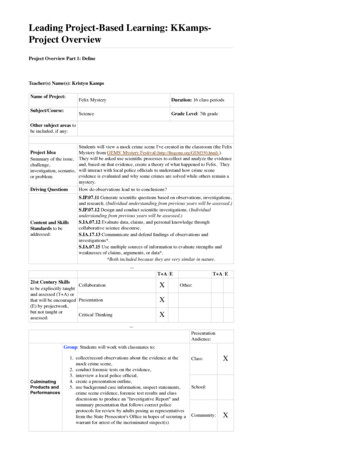
Transcription
1. Introduction to Project ManagementIntroductionRealization of these objectives requires systematic planning and careful implementation.To this effect, application of knowledge, skill, tools and techniques in the project environment,refers toproject management. Project management in recent years has proliferated, reachingnew heights of sophistication. It has emerged as a distinct area of management practicestomeet the challenges of new economic environment, globalization process, rapid technologicaladvancement, and quality concerns of the stakeholders.Project DefinitionProject in general refers to a new endeavor with specific objective and varies so widely that it isvery difficult to precisely define it. Some of the commonly quoted definitions are as follows.Project is a temporary endeavor undertaken to create a unique product or service or result.(AMERICAN National Standard ANSI/PMI99-001-2004)Project is a unique process, consist of a set of coordinated and controlled activities withstart and finish dates, undertaken to achieve an objective confirming to specific requirements,including the constraints of time cost and resource.(ISO10006)Examples of project include Developing a watershed, Creating irrigation facility,Developing new variety of a crop, Developing new breed of an animal, Developing agroprocessing centre, Construction of farm building, sting of a concentrated feed plant etc. It maybe noted that each of these projects differ in composition, type, scope, size and time.Project CharacteristicsDespite above diversities, projects share the following common characteristics. Unique in nature. Have definite objectives (goals) to achieve. Requires set of resources. Have a specific time frame for completion with a definite start and finish. Involves risk and uncertainty. Requires cross-functional teams and interdisciplinary approach.
Project Performance DimensionsThree major dimensions that define the project performance are scope, time, and resource.These parameters are interrelated and interactive. The relationship generally represented as anequilateral triangle. The relationship is shown in figure 1.TimeCostScopeFigure 1. Project performance dimensionsIt is evident that any change in any one of dimensions would affect the other. For example,if the scope is enlarged, project would require more time for completion and the cost would alsogo up. If time is reduced the scope and cost would also be required to be reduced. Similarly anychange in cost would be reflected in scope and time. Successful completion of the project wouldrequire accomplishment of specified goals within scheduled time and budget. In recent years aforth dimension, stakeholder satisfaction, is added to the project. However, the other school ofmanagement argues that this dimension is an inherent part of the scope of the project thatdefines the specifications to which the project is required to be implemented. Thus theperformance of a project is measured by the degree to which these three parameters (scope,time and cost) are achieved.MathematicallyPerformance f(Scope, Cost, Time)In management literature, this equilateral triangle is also referred as the “Qualitytriangle” of the project.Project Life CycleEvery project, from conception to completion, passes through various phases of a lifecycle synonym to life cycle of living beings. There is no universal consensus on the number ofphases in a project cycle. An understanding of the life cycle is important to successful completionof the project as it facilitates to understand the logical sequence of events in the continuum ofprogress from start to finish. Typical project consists of four phases- Conceptualization, Planning,2
Execution and Termination. Each phase is marked by one or more deliverables such as Conceptnote, Feasibility report, Implementation Plan, HRD plan, Resource allocation plan, Evaluationreport etc.Conceptualization PhaseConception phase, starting with the seed of an idea, it covers identification of theproduct / service, Pre-feasibility, Feasibility studies and Appraisal and Approval. The project ideais conceptualized with initial considerations of all possible alternatives for achieving the projectobjectives. As the idea becomes established a proposal is developed setting out rationale,method, estimated costs, benefits and other details for appraisal of the stakeholders. Afterreaching a broad consensus on the proposal the feasibility dimensions are analyzed in detail.Planning PhaseIn this phase the project structure is planned based on project appraisal and approvals.Detailed plans for activity, finance, and resources are developed and integrated to the qualityparameters. In the process major tasks need to be performed in this phase are Identification of activities and their sequencing Time frame for execution Estimation and budgeting StaffingA Detailed Project Report (DPR) specifying various aspects of the project is finalized tofacilitate execution in this phase.Execution PhaseThis phase of the project witnesses the concentrated activity where the plans are putinto operation. Each activity is monitored, controlled and coordinated to achieve projectobjectives. Important activities in this phase are Communicating with stakeholders Reviewing progress Monitoring cost and time Controlling quality Managing changes3
Termination PhaseThis phase marks the completion of the project wherein the agreed deliverables areinstalled and project is put in to operation with arrangements for follow-up and evaluation.Life Cycle pathThe life cycle of a project from start to completion follows either a “S” shaped path or a“J “ shaped path (Figure 2 and 3). In “S” shape path the progress is slow at the starting andterminal phase and is fast in the implementation phase. For example, implementation ofwatershed project. At the beginning detailed sectoral planning and coordination among variousimplementing agencies etc. makes progress slow and similarly towards termination, creatinginstitutional arrangement for transfer and maintenance of assets to the stakeholders progressesslowly.Error!Percentage completion100Slow finishQuickMomentumSlow startTimeFigure 2. Project life path –“S” shapeIn “J” type cycle path the progress in beginning is slow and as the time moves on theprogress of the project improves at fast rate. Example, in a developing an energy plantation. Inthis the land preparation progresses slowly and as soon as the land and seedling aretransplantation is under taken. This is shown in figure 3.4
% CompletionError!100TimeFigure 3. Project life cycle path - “J” ShapeProject ClassificationThere is no standard classification of the projects. However considering project goals, thesecan be classified into two broad groups, industrial and developmental. Each of these groups canbe further classified considering nature of work (repetitive, non-repetitive), completion time (longterm, shot term etc), cost (large, small, etc.), level of risk (high, low, no-risk), mode of operation( build, build-operate-transfer etc).Industrial projects also referred as commercial projects, which are undertaken to providegoods or services for meeting the growing needs of the customers and providing attractivereturns to the investors/stake holders. Following the background, these projects are furthergrouped into two categories i.e., demand based and resource / supply based. The demand basedprojects are designed to satisfy the customers’ felt as well the latent needs such as complexfertilizers, agro-processing infrastructure etc.The resource/ supply based projects are thosewhich take advantage of the available resources like land, water, agricultural produce, rawmaterial, minerals and even human resource. Projects triggered by successful R&D are alsoconsidered as supply based. Examples of resource based projects include food product units,metallurgical industries, oil refineries etc. Examples of projects based on human resource (skilled)availability include projects in IT sector, Clinical Research projects in bio services and others.5
Development projects are undertaken to facilitate the promotion and acceleration of overalleconomic development. These projects act as catalysts for economic development providing acascading effect. Development projects cover sectors like irrigation, agriculture, infrastructurehealth and projectsandDevelopmentalprojectaresumerised in the following table 1.Table 1. Difference between Industrial and Developmental ProjectsDimensionIndustrial ProjectDevelopmental ProjectScale of ProjectLimitedLargePromotersEntrepreneurs or corporatesGovernment, Public Sectors,NGOsInvestment---HighGestation Period---HighProfitabiltyHigh, Considered on IRR (Modest, Considered on ERRInternal Rate of Return)(Economic Rate of Return)Stringent debt equity normsOperates on higher debt-Financeequity normsSource of fundNational stock markets tly as loan ,yet timesproviding for some grants.Interest rates and repaymentMarketrateandtheVery low for borrowed fundsperiod:repayment period is generallyand the repayment period7 to 10 yearsextends up to 25 years andeven beyond.Project managementProject management is a distinct area of management that helps in handling projects. Ithas three key features to distinguish it from other forms of management and they include: aproject manager, the project team and the project management system. The projectmanagement system comprises organization structure, information processing and decisionmaking and the procedures that facilitate integration of horizontal and vertical elements of the6
project organization. The project management system focuses on integrated planning andcontrol.Benefits of Project Management ApproachThe rationale for following project management approach is as follows. Project management approach will help in handling complex, costly and riskyassignments by providing interdisciplinary approach in handling the assignments.Example: R&D organizations. Project management approaches help in handling assignments in a specified timeframe with definite start and completion points .Example handling customerorders by Industries involved in production of capital goods. Project management approaches provide task orientation to personnel in anOrganization in handling assignments. Example: Organizations in IT sectorhandling software development assignments for clients.7
2. Project Identification and FormulationIntroductionA project in the economic sense directly or indirectly adds to the economy of the Nation.However an introspection of the project performance clearly indicates that the situation is farfrom satisfactory.Most of the major and critical projects in public sector that too in crucialsectors like irrigation, agriculture, and infrastructure are plagued by tremendous time and costoverruns. Even in the private sector the performance is not all that satisfactory as is evidentfrom the growing sickness in industry and rapid increase in non-performing assets (NPAS) ofBanks and Financial Institutions. The reasons for time and cost over runs are several and theycan be broadly classified under-technical, financial, procedural and managerial. Most of theseproblems mainly stem from inadequate project formulation and haphazard implementation.Project IdentificationProject identification is an important step in project formulation. These are conceivedwith the objective of meeting the market demand, exploiting natural resources or creatingwealth. The project ideas for developmental projects come mainly from the national planningprocess, where as industrial projects usually stem from identification of commercial prospectsand profit potential.As projects are a means to achieving certain objectives, there may be several alternativeprojects that will meat these objectives. It is important to indicate all the other alternativesconsidered with justification in favour of the specific project proposed for consideration.Sectoral studies, opportunity studies, support studies, project identification essentiallyfocuses on screening the number of project ideas that come up based on information and dataavailable and based on expert opinions and to come up with a limited number of project optionswhich are promising.Project FormulationProject Formulation Concept“Project Formulation” is the processes of presenting a project idea in aform in which it can be subjected to comparative appraisals for the purpose ofdetermining in definitive terms the priority that should be attached to a project8
under sever resource constraints.Project Formulation involves the followingsteps (Figure 1).PROJECT FORMULATION OPPORTUNITY STUDIES/Support Studies IDENTIFICATION OF PRODUCT/SERVICE PREFEASIBILITY STUDY FEASIBILITY STUDY(TECHNO ECONOMIC FEASIBILITY) PROJECT APPRAISAL DETAILED PROJECT REPORTFigure 1. Project Formulation –Schematic viewOpportunity StudiesAn opportunity study identifies investment opportunities and is normally undertaken atmacro level by agencies involved in economic planning and development. In general opportunitystudies there are three types of study – Area Study, sectoral and Sub-sectoral Studies andResource Based Studies. Opportunity Studies and Support studies provide sound basis for projectidentification.Pre feasibility Studies / Opportunity StudiesA pre-feasibility study should be viewed as an intermediate stage between a projectopportunity study and a detailed feasibility study, the difference being primarily the extent ofdetails of the information obtained. It is the process of gathering facts and opinions pertaining tothe project. This information is then vetted for the purpose of tentatively determining whetherthe project idea is worth pursuing furthering.Pre feasibility study lays stress on assessingmarket potential, magnitude o
Introduction to Project Management Introduction Realization of these objectives requires systematic planning and careful implementation. To this effect, application of knowledge, skill, tools and techniques in the project environment, refers to project management. Project management in recent years has proliferated, reaching new heights of sophistication. It has emerged as a distinct area of .











